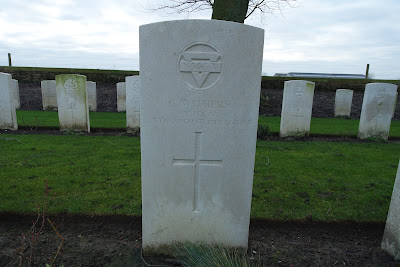Ypres Salient 2018: Day Two
We started this morning with a delicious continental breakfast at Talbot House: cereals, breads, pastries ... even chocolates!
Our first visit of the day was to Vlamertinghe New Military Cemetery where YMCA worker Cecil Withers is buried, having died in August 1917. I haven't yet found out how he died, whether illness or injury, but it is most likely that he worked at a hut based in Vlamertinghe, which was on the limit of the range of German artillery and served as Field Ambulance and Allied artillery headquarters during the war. Withers is the only YMCA worker to be buried in Belgium. They were non-combatants and as such were usually outside of any great danger. Nonetheless, he has been afforded a military grave the same as all others, with the inverted triangle of the Association engraved in the top.
Next we drove east of Ypres to Zonnebeke to visit the Memorial Museum Passchendaele. Mum and I have both visited before but neither of us had done the very interesting audio tour and we still found it such a fascinating museum. The museum has lots of artefacts, which I love, but they are all well-curated and do not feel at all cluttered. The audio guide also gave a lot of supporting information without having to do a lot of reading.
This is, in my opinion, the best First World War museum I have visited. It's redesign which was unveiled at the start of the centenary is really well thought out, with dugout and trench experiences connecting different parts of the museum and giving a sense of what the battlefield was like. Of course, they are too clean, square and well-buolt compared with the originals, but they still give some insight into what the soldiers' space was like.
There is also a very good video and diorama which shows the Allied advance in the Third Battle of Ypres, showing very clearly on the map how each village was captured.
My favourite artefact in the museum (although many were very interesting) was a Canadian YMCA 'Rhymes of the Red Triangle' book. Unfortunately we weren't able to look inside! I was pleased to see several references to the YMCA around the museum.
While we were in the museum the sun had come out beautifully and begun to warm the freezing wind. We then drove up to Tyne Cot Cemetery and Memorial where we parked for our walk.
This week it seems that the Salient is very quiet of visitors and even up at Tyne Cot there weren't many people about. We had a short wander around the cemetery taking photos in the lovely winter light. Two headstones that stood out were those of Major H Leech (King's Liverpool) and Private H Brawn (Canadian Infantry) whose graves both bore Christian epitaph, yet neither had a cross. An interesting choice made by their families.
From here we followed a short section of Paul Reed's Passchendaele walk route, out through the feature known on British maps as Marsh Bottoms and then up to the Canadian memorial at Crest Farm. There is no better way to understand the landscape of the battlefields than actually walking it and we could see this on Passchendaele Ridge where the fields twisted and dipped in different places.
Retracing our steps back to the car, we felt a few snowflakes on the wind as the clouds came and went. Our next visit was to Yorkshire Trench, north of Ypres, and by the time we arrived the wind had picked up and was freezing cold. As we navigated our way through the industrial estate to the trench, the wind was also blowing across the gross stench of biomass from one of the industrial units. Luckily, Yorkshire Trench was upwind!
This preserved section of trench was uncovered by amateur archaeologists in the 1990s, when building work began in the area. Although only small, it was interesting to see a glimpse of the trench formations, as well as the imprint of where dugouts ran below ground. It was a reminder, amid the modernisation which now surrounds the site, of the traces of war which run below our feet across the Salient.
Next we crossed over the canal to visit Essex Farm cemetery, noted as the Field Ambulance site where John McCrae wrote In Flanders Fields. The concrete bunkers here were used to carry out medical procedures: it must have been very dark and damp!
The accompanying cemetery contains the graves of many who died from their wounds including Sapper FH Pereira of the Royal Engineers. His touching epitaph reads 'We salute our dear boy/ A volunteer/ Au Revoir'. I found it quite poignant that his family felt it important to note that he was a volunteer soldier, not a conscript, and that he freely gave his life for the cause.
By now we were freezing cold so drove south into Ypres to refuel with delicious waffles and hot chocolate, followed by a potter around a few of the shops that were open on a Sunday afternoon.
We then drove back from Ypres towards Poperinge, stopping off at the Hop Store Cemetery in Vlamertinge, just as the sun began to dip and the shadows lengthen. The small cemetery looked beautiful in the evening light, a peaceful spot between the farmers' fields.
We made it back to Talbot House in enough time to have a look around the chapel with the sunlight pouring in through the windows and for some down time (to write this blog!) before dinner.
Tomorrow we go in search of a YMCA hut and take a walk around Hill 60.
Kathryn














No comments: